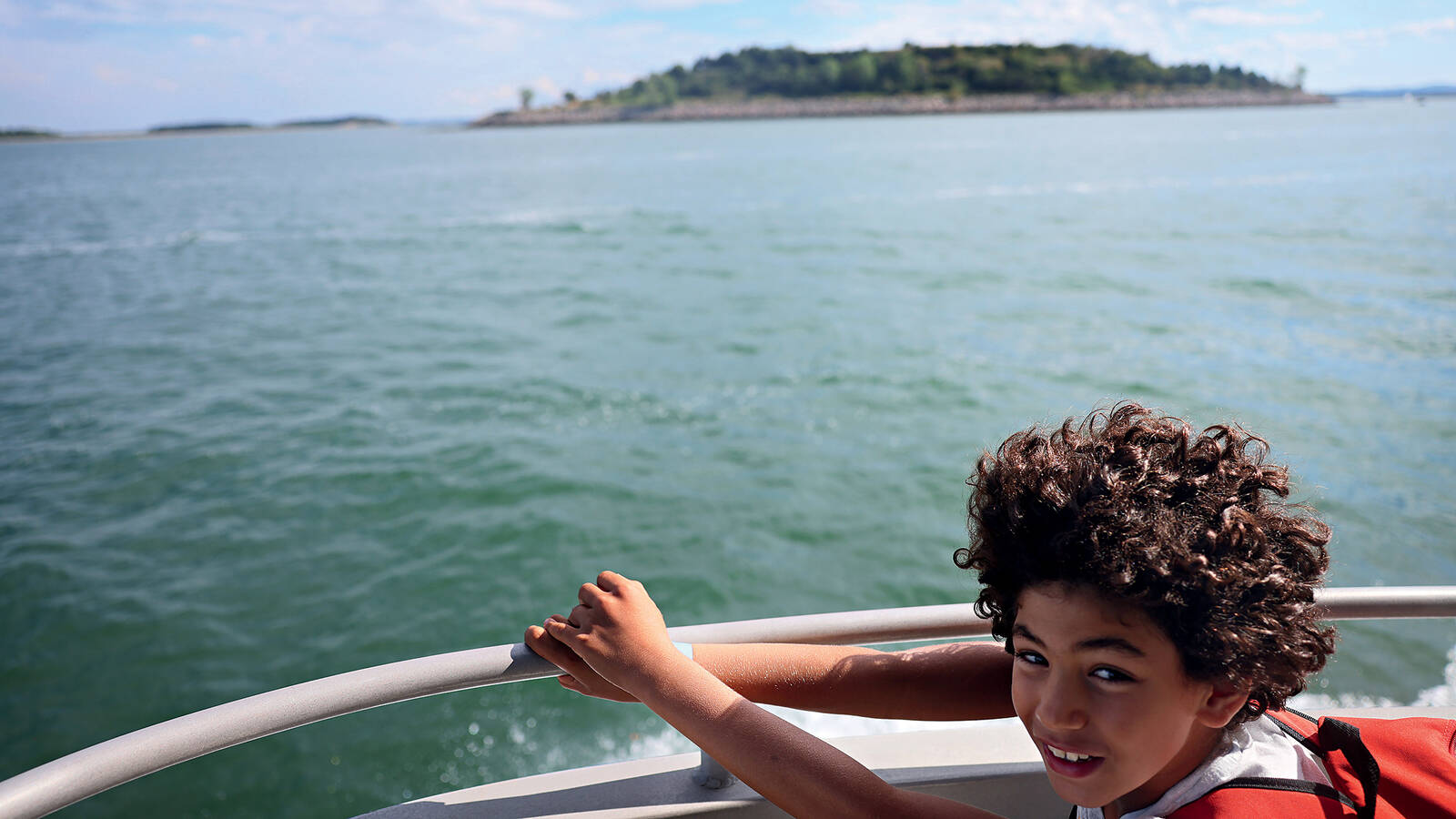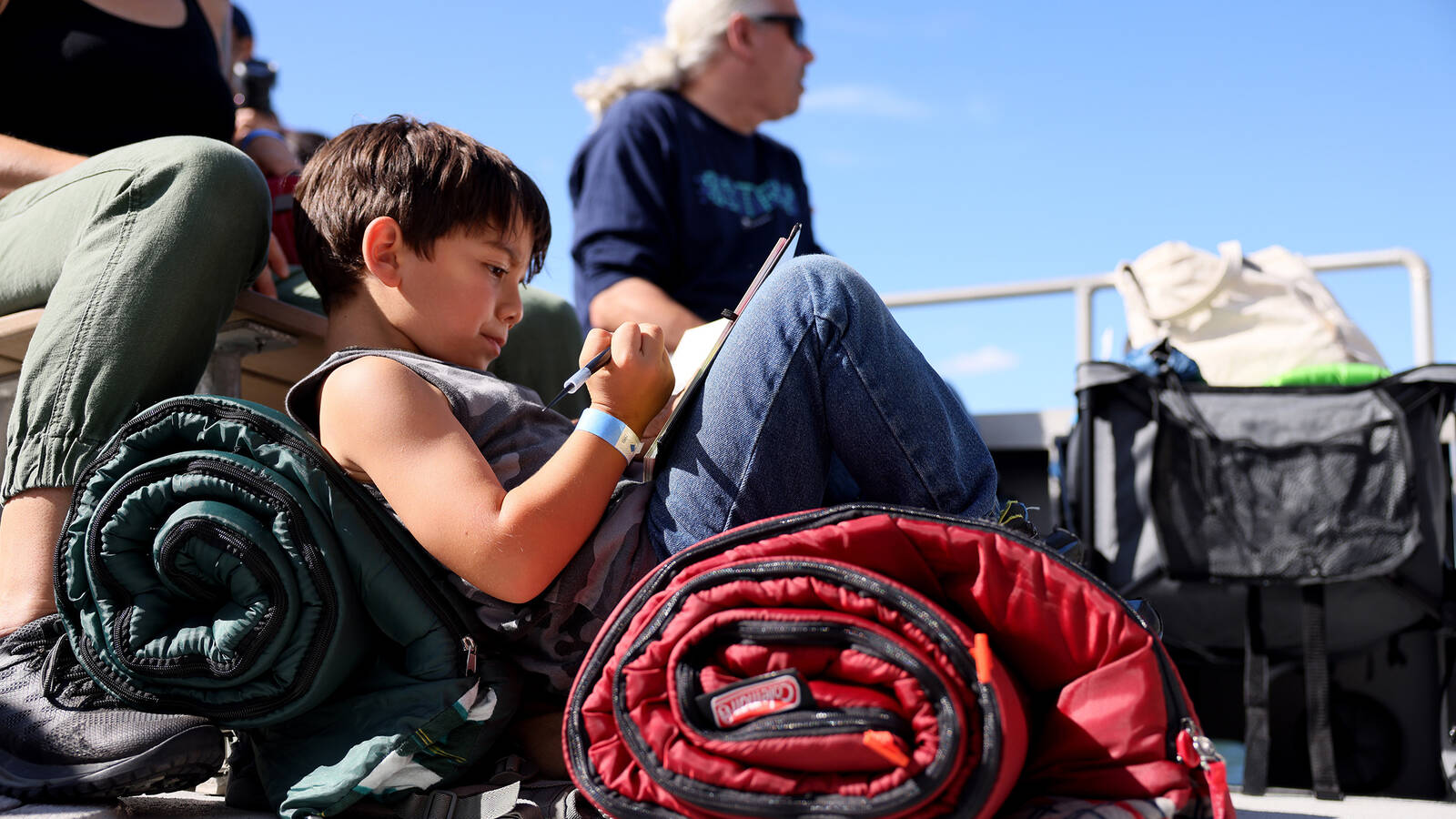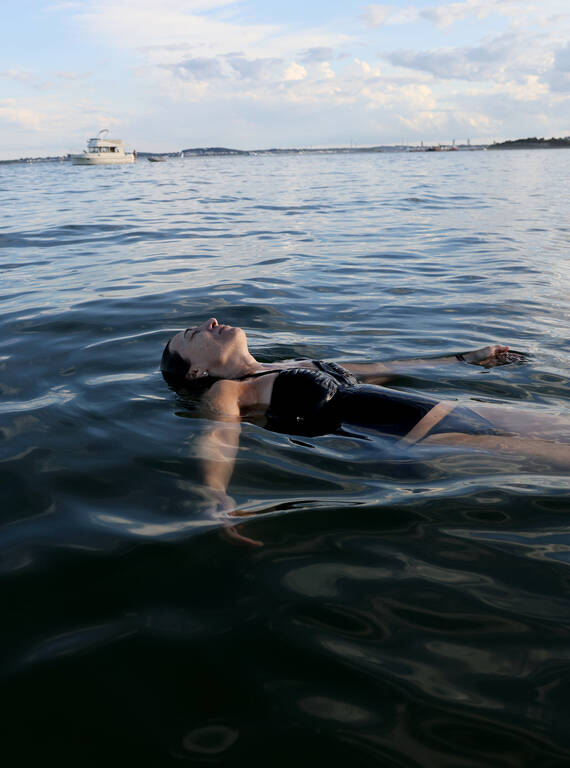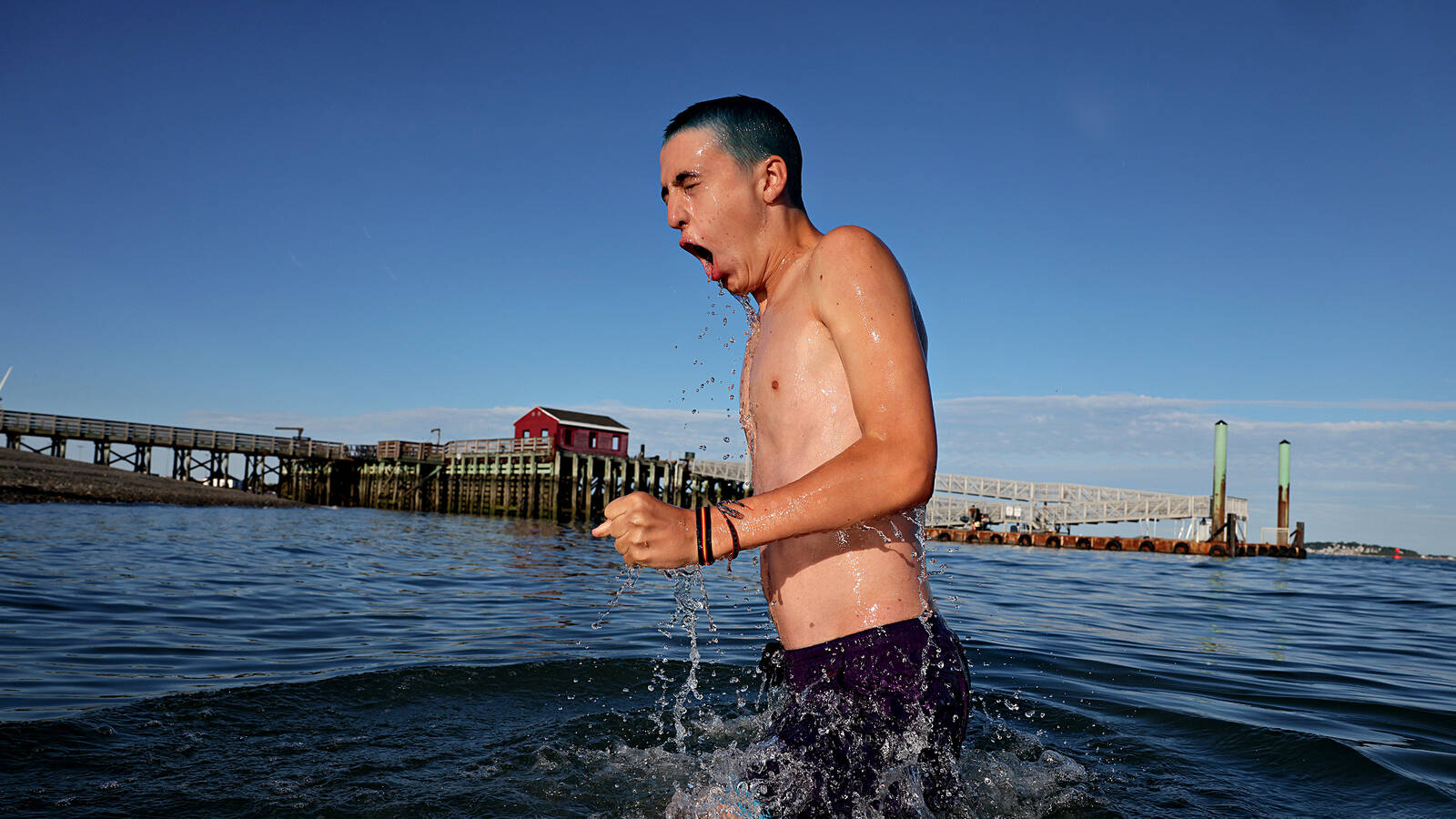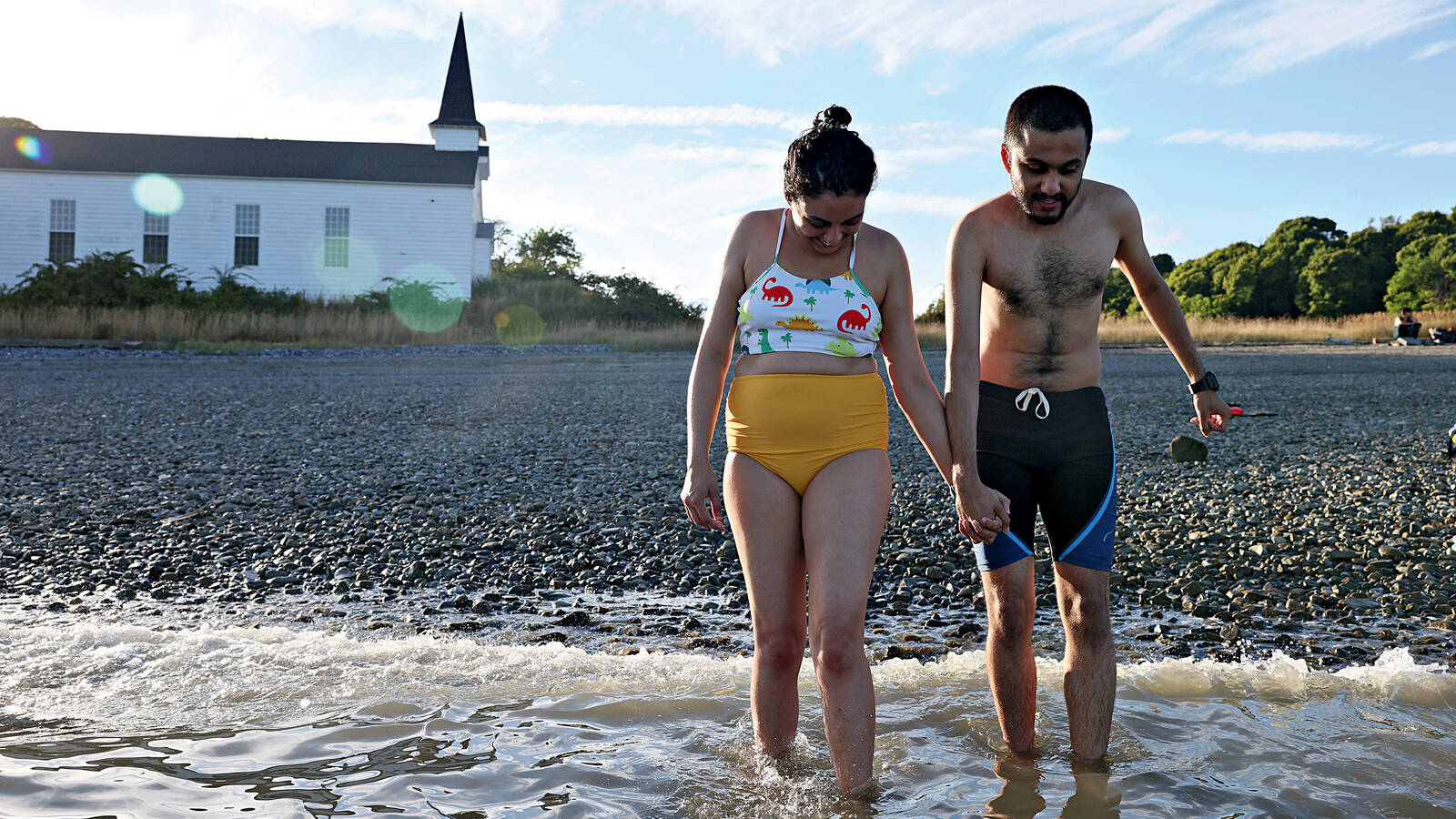Summer 2023
Offshore Escape
The Boston Harbor Islands are a world apart from the city — but just a ferry ride away.
“Folks, if you’re on the top deck, cover your ears,” the captain advised over the intercom. I was indeed on the top deck, and I did as I was told. The boat’s horn blasted through Boston’s Inner Harbor, and the engine churned. Although the ferry crowd was sparse at 10 o’clock on a Thursday morning, Long Wharf already bustled. I’d made it to the pier just in time, beelining from a garage near the New England Aquarium through herds of pedestrians, then flashing the ticket on my phone to the attendant before clanking over the gangplank, my daypack slung on my shoulder.
Now settled in my blue plastic chair under an overcast, mid-August sky, catching scents of brine and diesel, I felt ready for a little adventure, all within miles of my apartment. I was headed to Georges Island, one of the most visited sites in Boston Harbor Islands National Recreation Area, which includes 34 islands and peninsulas scattered throughout the harbors and bays of Boston and its outlying coastal towns.
Georges was the first of three islands I’d visit over three days. Peddocks Island, next on my itinerary, had been closed for part of the pandemic, but its campsites were open to visitors again, and my wife, Maggie, and I had signed up for a Friday overnight excursion with a stargazing group. Then, on Saturday, we’d hop another ferry to Spectacle Island for an evening beer garden event, part of a series of programs celebrating the islands’ twin anniversaries: 50 years as a state park, and 25 years as a national park.
Four of the Boston Harbor Islands (Georges, Spectacle, Peddocks and Thompson) have seasonal ferry access from Boston or Hingham. Other islands are reachable by private boat, and the peninsulas that are part of the recreation area — including Deer Island and World’s End — are accessible from the mainland. For now, camping is limited to Peddocks. The more popular islands have plumbed or composting restrooms, but conditions are rustic overall; bring snacks, plenty of water and sunscreen, and count on packing out your trash. Check BostonHarborIslands.org for ferry schedules and costs. ©KAREN MINOT
Owned by the commonwealth of Massachusetts and a patchwork of other entities, the parkland (ranging from 1,500 to 3,050 acres depending on the tides) and 35 miles of shoreline are overseen by a partnership of 11 agencies including the National Park Service, the Massachusetts Department of Conservation and Recreation, and the nonprofit group Boston Harbor Now. Four of the islands are easily accessible by ferry, including Thompson Island, which is managed by an Outward Bound school and hosts outdoor education programs. Others are closed to visitors or closed seasonally to protect breeding birds, or they can be accessed only by private boat.
I’d known of this urban archipelago for years but had only recently learned the word “drumlins” — mounds of glacial till deposited around 12,000 years ago. Over time, receding glaciers flooded the region, but the islands were left exposed, rising from the sea like whalebacks. Most of the harbor islands are drumlins, including Georges Island, which is actually two drumlins that were re-sculpted and connected in the mid-1800s during the construction of Fort Warren, a Civil War-era structure and former prison camp.
Youssef Elhabbak stands at the bow of a ferry on his way to Peddocks Island, one of 34 islands and peninsulas that make up Boston Harbor Islands National Recreation Area.
©JESSICA RINALDIRye Galindo draws in a book about dinosaurs while on his first boat trip.
©JESSICA RINALDII sent a check-in text to Maggie, who was stuck at work but would join me the next day. The summer had been full of job obligations and lingering pandemic unease, and we were eager for some fun. In recent years, staying in Boston had become less certain for us. Rents kept climbing, and though we liked our cozy corner of the city’s Brighton neighborhood, visits to Maggie’s childhood home in New Hampshire always stirred longings for more space, more trees and less of that famously tangled Boston traffic. Every year, it came up: Should we move? But after spending most of our adult lives in New England’s largest metropolis, could we give up our favorite sushi spots? Or the pubs where we’d had our first dates? Beneath the day-to-day concerns was a harder-to-answer question: Did we really belong in this city or just live here? What makes a place home?
I hoped the islands might prove Boston could still surprise us. We’d never visited them before, and an offshore escape with skyline views sounded perfect. At the very least, we’d get glimpses of a unique ecosystem — the watery fringe of a nearly 400-year-old city that, despite our occasional doubts and restlessness, we’d become part of.
After a 45-minute ride to Georges, passengers spilled onto the dock. Fort Warren is the island’s main event, a pentagon-shaped configuration of bastions and batteries. But I was first drawn to the trails along the shoreline. I wandered to the rocky beach, then up an embankment built to absorb cannon fire from enemy ships. The fort took two decades to finish, and by the time it was dedicated in 1847, weaponry had advanced, making its defensive design obsolete. With trees now rooted in the ramparts, the site has a reclaimed-by-nature feel. Above the fort’s granite walls, hundreds of swallows swirled and chattered.
Then, a pleasant surprise. On the ferry ride over, I kept hearing a distinct, charmingly goofy laugh that reminded me of my days at Boston University, the school that brought me to the city two decades ago. Now, I realized my ears weren’t playing tricks. Tramping down a set of stone steps was Mike, an old college roommate I hadn’t seen in about 10 years.
“Whoa, this is weird,” he said, and I heard that laugh again. We stood on the grass, catching up. A software engineer, he was on a team-building outing that he’d organized for his co-workers. We soon parted ways, but on an island with only 39 exposed acres at high tide, I figured we’d cross paths again.
During the Civil War, Fort Warren housed around 2,300 inmates, mostly Confederate soldiers, along with some political prisoners and Union deserters. Around the corner from the fort’s entrance, a sign marks a narrow musketry “loophole” where in 1863, a skinny prisoner squeezed through after chipping away the edges. He plunged into the channel and swam for it but was eventually caught. Despite several such escape attempts by inmates, the camp was known for relatively humane treatment; prisoners were given newspapers, free time and bread from an on-site bakery.
Indigenous Peoples of the Bay
Around noon, the island’s atmosphere went from hushed to rambunctious as packs of kids from camps arrived. They roamed and conversed excitedly on the open-air parade ground inside the fort walls. Craving a bit of solitude, I found a quiet bench facing the ocean and watched the pulses of Boston Light, about 2 miles away on Little Brewster Island. The light station is the oldest continually operating in the U.S. and is one of the last to have a keeper. Lulled by lapping surf and the far-off dinging of buoys, I wondered what it was like to spend your days surrounded by water.
I decided to catch the 3 p.m. ferry back, and sure enough, Mike and his co-workers had the same idea. As he and I reminisced about old friends, I felt a strange loop-de-loop of time. I’d come looking for a new slice of Boston, and here I was, immersed in my earliest memories of the city.
The next morning, Maggie and I had an early wake-up. Our amateur astronomy group wouldn’t arrive until evening, but we wanted a full day on Peddocks. After grabbing lunch provisions at a neighborhood deli, we drove about 45 minutes to the town of Hingham on the South Shore, and soon we were boarding a small ferry with around 10 others.
The sky was pure blue as we cruised through the sun-drenched bay, weaving around Grape and Bumpkin islands. “This is a special place,” I said, a little surprised at my own earnestness. “What, Boston?” Maggie asked. I knew what she was thinking: You mean this place we’re always talking about leaving? But she was smiling, too, and I could already see her shoulders relaxing.
As we docked at Peddocks, we saw the red brick, slate-roofed barracks of Fort Andrews surrounded by sloping hills and deep stands of trees. Due to its secluded, windswept look, the island served as a backdrop for the movie “Shutter Island,” Martin Scorsese’s 2010 thriller. Long before that, the fort was active for two wars; during World War II, it functioned as a POW camp for around 1,800 captured Italian soldiers.
At the visitor center, a ranger kindly let us stash our stuff and schooled us on the island’s resident deer — “They’ll stare you down,” he said. Outside, we wandered to a white clapboard church, built in 1941. It was closed to visitors, but we lingered over a bed of lavender swarmed with butterflies and bees. Bees, it turns out, are abundant on the islands — over 170 species have been cataloged in the park. And not just bees. Starting in 2005 scientists worked with the Park Service to launch a biodiversity inventory, enlisting a citizen army of experts, amateur biologists and school kids to collect and label insect specimens.
Brian D. Farrell, a professor of organismic and evolutionary biology and curator of entomology at the Harvard Museum of Comparative Zoology, pitched the inventory idea after touring the islands with his colleague, the late biologist and author E.O. Wilson, who coined the term “microwilderness” to describe the vast but often overlooked world of invertebrates.
The project’s volunteers gathered approximately 160,000 arthropods and gastropods from 19 islands and peninsulas over six years. As they delved into the painstaking work of identifying specimens, even Wilson was surprised at the breadth of what was discovered. “Ed had offered some guesses as to how many ants we’d find,” Farrell said. “He thought we’d have like 20 species out there, and it was three or four times that.”
Ana Hoffman floats in the bay off Peddocks Island.
©JESSICA RINALDIWater-based activities from boating and fishing to swimming in the frigid bay (demonstrated by Lucas Hoffman) are a primary attraction for the thousands of visitors who flock to Boston Harbor Islands every year.
©JESSICA RINALDIA couple take their first tentative steps into the bay off Peddocks Island.
©JESSICA RINALDIPeddocks is shaped like a curved spoon, and Maggie and I set off from East Head — the bowl of the spoon — along a paved path toward Middle Head, where we explored a marsh, spotting ravens and scattering grasshoppers. Then, after a quick lunch, we changed into our swimsuits and ducked through trees to a cobble beach. It was nearly 80 degrees, but we knew the Atlantic would be cold. And oh, it was. We cringed and laughed as we eased into the water. Once we adjusted, though, it was a thrill floating in the bay with boats speeding by in the near distance.
After drying off, we strolled a ways down the beach, and noticed a wooden ladder. At the top, a manicured yard led toward a path into the woods. We both hesitated. “Let’s check it out,” I said. We were soon ensconced by thick trees. Wild raspberries dangled at the path’s edge.
When we emerged, we saw more tidy yards and several modest houses — shingled or clapboard, some with brick chimneys. One was bright pink, with solar panels and blue water barrels outside. We passed a wooden display board decorated with an assortment of flip-flops and a hand-painted sign reading “Island of Lost Soles.” We’d stumbled into the Peddocks Island cottage community. In the 1880s the city began expanding a hospital on Long Island — the largest of the harbor islands — and Portuguese fishing families living on the island were displaced. Many of the families somehow found their way to Peddocks, and the relocation began: Some brought their houses over in pieces by boat, others reportedly used empty barrels to float whole structures across the channel. Over time, most cottages became vacation homes. When Massachusetts acquired the island in 1970, the cottagers began paying rent to the state.
Cathy Stanton, a cultural anthropologist, studied the cottagers’ deep, multigenerational connections to Peddocks in an ethnographic study the Park Service hired her to do a decade ago. “It’s an escape that feels like your true home,” she said. “That’s the magic of those summer places.”
On our way back to the beach, we met Jon Hale, whose great-grandfather was part of a wave of Italian Americans who began visiting Peddocks in the early 1900s. Hale’s cottage has been in his family since 1949. “I was born in May, and I was here in June,” he said. Now 58, Hale makes the trip from his home in Vermont every other weekend from Memorial Day to early October. The cottages are off the grid, but Hale has propane appliances, solar chargers and a well with non-potable water, one of 30 or so on the island. He lamented that a dozen of the roughly 40 cottages had been torn down, referring to a policy change in 1993: The park extended leases only to current owners, so the cottages can’t be passed on. Over the years, site managers have floated several proposals for what to do with the cottages that range from preserving some for their historic value to razing them all to create recreational space. Hale plans to steward his family getaway as long as possible. “They’ll have to remove me,” he joked.
Soon we joined our fellow campers, who arrived wheeling carts full of supplies. Then setup commenced: out came tents of all sizes, camping chairs, portable grills. The group of around 60 hailed from all over the Boston area and beyond, and many were first-time campers.
After Maggie and I pitched our tent, I chatted with some of our neighbors. Mayur Bhat, an astral photography enthusiast, had come with his partner, Niharika Sane, and several friends they’d met as graduate students at Northeastern University. Demall Taylor and Aja Pickett said it was their first visit to Peddocks, but as native Bostonians, they’d been to Georges Island many times on school trips.
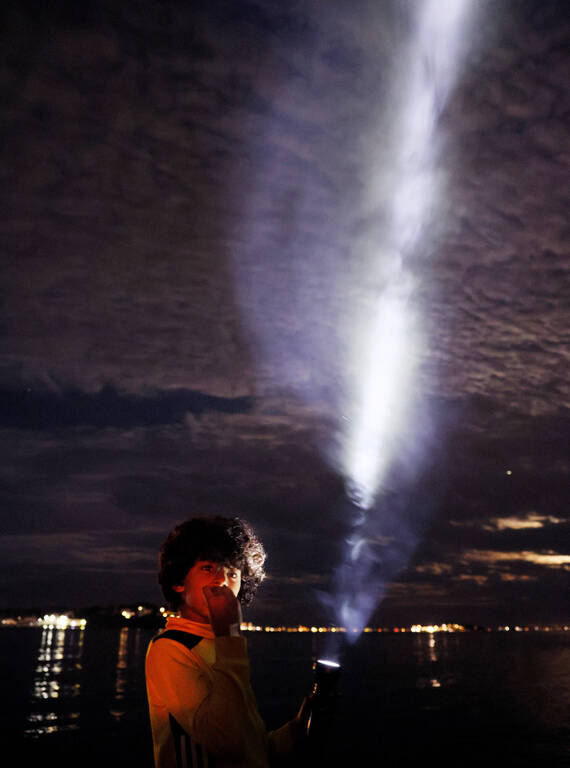
Youssef Elhabbak lights up the night during an evening event on Peddocks Island.
©JESSICA RINALDIBefore dusk set in, a ranger led us on a sunset walk on East Head’s trails. She said coyotes had been spotted near a thicket over yonder. Coyotes? It was the best kind of trick. With our eyes drawn to the bushes, we were completely blindsided when the path opened up to a lookout point with a perfect view of the distant skyline. We all packed together, phones and cameras raised, as the sky flared orange above Long Island, with miniature buildings beyond. “All those hundreds of thousands of people out there,” a man beside me mused, pinching the city between his fingers, “and it’s like this big.”
Back at the beach, it was campfire time. As the sky darkened, ingredients for s’mores appeared, and kids twirled glow sticks. A few small potbellied telescopes were set out, but the skies had clouded over, putting a damper on the stargazing. Eventually, however, some stars peeked out, and the moon emerged, throwing a column of light over the waves.
While campers toasted marshmallows, I talked with Paul Castro, a wiry, affable guy who was diligently tending the fire. Each of the islands I visited, it turned out, has a full-time groundskeeper, and Castro is the live-in caretaker on Peddocks. A former Marine, he’d grown up in Hull, just across the water. As we spoke, we could see the lights of the high school stadium where he used to play football. Castro works with a small crew through the winter, when the weather is harsh but the island is at its quietest. “That’s my favorite time, hands down,” he said.
In the morning, Maggie and I woke to the soothing churn of waves. She fired up the camp stove for coffee. On a short walk to the sea, I saw wild turkeys grazing on a gravelly path and an osprey flapping out over the water.
Soon Maggie and I departed for Hingham, where we changed into slightly nicer duds for the evening event on Spectacle Island before hightailing it back to the city. We had just enough time for lobster rolls and a couple of beers at James Hook & Co., and then it was on to the Long Wharf dock and a packed, triple-decker ferry.
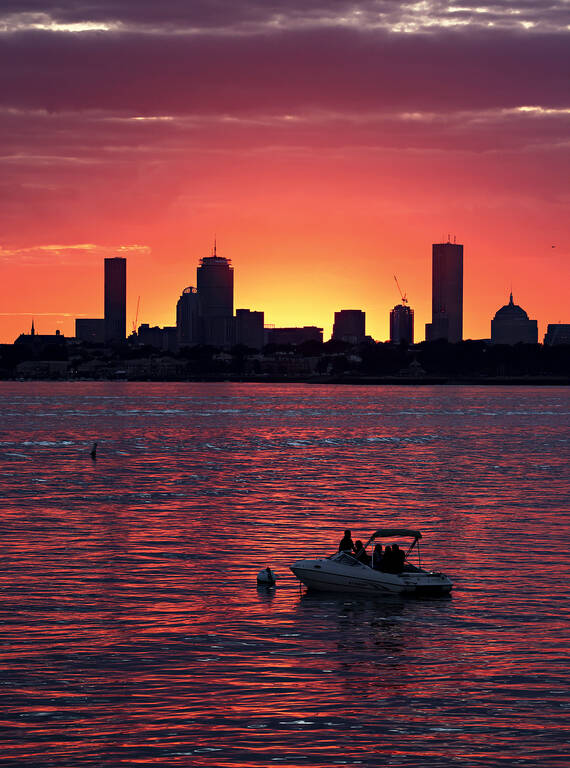
Boaters anchored off Spectacle Island, one of nearly three dozen islands and peninsulas within Boston Harbor Islands National Recreation Area.
©JESSICA RINALDI“It was once a big pile of trash,” the captain said, referring to our destination, “Don’t make it a big pile of trash again.” It is true: Spectacle Island was used for waste processing and as a city dump from 1902 to 1959, during which time it grew by more than 35 acres and leaked toxins into the harbor. As Boston’s “Big Dig” project dragged on through the 1990s, crews unloaded millions of cubic yards of dirt at the site to create a graded, habitable island, with prime views of the city. The park opened to the public in 2006.
Once we’d disembarked, we climbed a spiraling path to the top of the north drumlin, the highest point on any of the islands at some 160 feet. The day had a lazy summer vibe, and by the time the music started and the band’s lead singer — in a Grateful Dead shirt and heart-shaped sunglasses — began a cover of “Isn’t She Lovely,” hazy silhouettes were filing out of another big ferry. Within minutes, lines for beer and food were snaking around the visitor center.
After a while, Maggie and I stole away to walk the beach, where we seemed to spot sea glass in every color, one perk of exploring a former landfill. Before the event wrapped up around dusk, we were treated to another stunning sunset photo op. Under a purple net of clouds, the skyline was backlit dramatically, turning wild orange first, then rosy pink. A jet dipped slowly through the scene, disappearing and reappearing in the glare. It was the city we knew — but unlike we’d ever seen it.
Squinting a little, I thought I could make out the blocky walls of City Hall, where we were married. Boston had become the backdrop of our story. This trip was yet another bright spot. Sure, we’d stay open to change, but we’d carved out a niche where, for now, we still seemed to fit.
ABOUT THE PHOTOGRAPHER
Waiting in line for the return ferry, I spotted Castro, who had island-hopped to help out with the event. I asked him who was following who, and he laughed, and said he’s always around. “These islands are my life,” he said.
On the ferry ride back, the boat buzzed with camaraderie. The skyline still glowed faintly, then blue and yellow lights began blinking on in the dark. As we pulled into the wharf, a wedding was underway in the aquarium’s event space, and the band at the window turned around, midsong, and raised their brass to us in salute. We all cheered. Maggie and I made our way back to the car over brick sidewalks, exhausted, salt still in our hair. Granted, we’d just gotten off a boat, but I couldn’t deny it: The ground felt more solid under my feet.
About the author
-
 Dorian Fox Contributor
Dorian Fox ContributorDorian Fox is a writer and freelance editor whose essays and articles have appeared in various literary journals and other publications. He lives in Boston and teaches creative writing courses through GrubStreet and Pioneer Valley Writers' Workshop. Find more about his work at dorianfox.com.
